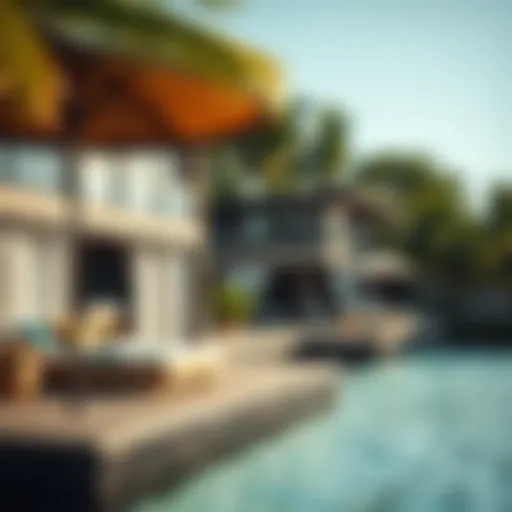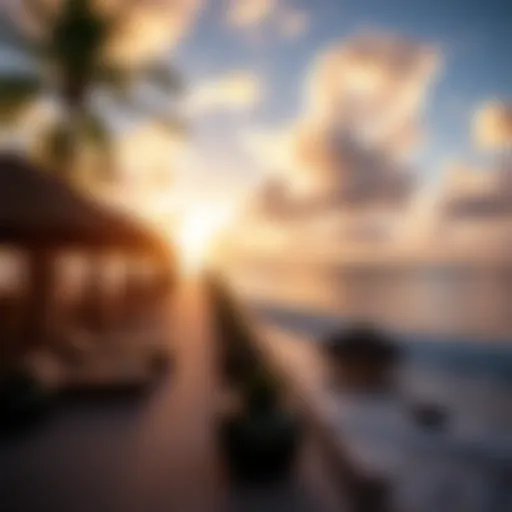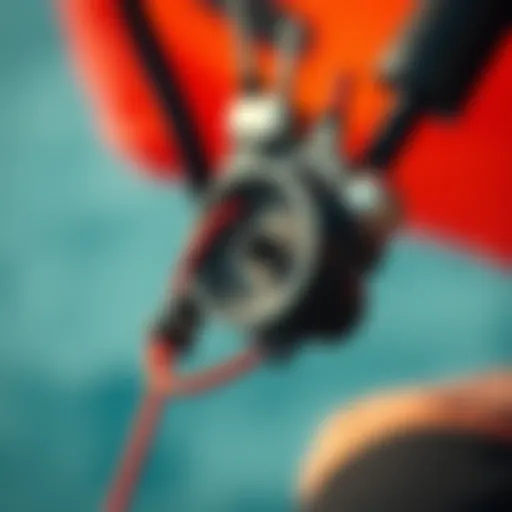Exploring High Quality Kites for Better Performance


Intro
Kiteboarding, a blend of surfing and flying, grants adrenaline junkies the chance to glide over sparkling waters while harnessing the power of the wind. However, the sport's enjoyment and safety hinge significantly on a kite’s quality. Understanding what makes a kite top-notch can mean the difference between a smooth ride and a harrowing experience. This article aims to unpack the essentials surrounding high-quality kites, diving into the elements that distinguish them in the bustling kiteboarding community.
The choices available can be overwhelming, especially for those just starting out. From materials to design, each component plays a critical role in the performance and durability of the kite. We will explore how selecting the right kite not only enhances one's experience but also ensures safety on the water—crucial for both novices and seasoned veterans alike.
Additionally, we’ll touch on maintenance practices that will extend the life of the kite and optimize performance in varying conditions. With insights from experts in the field, this guide strives to elevate your understanding and appreciation of what constitutes high-quality kites.
Gear Insights
Latest Gear Reviews
In kiteboarding, the gear one chooses is paramount. High-quality kites are often crafted from specific materials designed to withstand harsh conditions while providing excellent performance. For instance, the Naish Pivot is renowned for its versatility, ideal for both freestyle and wave riding. Integrating a hybrid construction, it features progressive tip shapes and adjustable bridle settings for varied wind conditions. Meanwhile, the Ozone Edge exemplifies performance in gusty winds, presenting a stable and consistent lift, particularly favored by racers.
When diving into gear reviews, it's helpful to break them down by categories, such as:
- Material: Look for kites made from durable ripstop nylon or polyester for longevity.
- Design: High-aspect ratio kites often provide better upwind performance.
- Ease of Use: Novices may appreciate kites with simpler setups and more forgiving characteristics.
Essential Gear for Beginners
For those new to kiteboarding, selecting the right gear can be a game-changer. Investing in beginner-friendly kites, such as the Slingshot B2, which boasts stability and a wide wind range, can minimize the learning curve. Additionally, it is vital to consider:
- Safety Gear: Helmets and impact vests provide essential protection, especially during early lessons.
- Control Bar and Lines: A good control bar not only enhances handling but also incorporates safety features such as quick-release systems.
- Board Selection: A larger board offers better flotation, making it easier to learn the ropes.
Techniques and Tips
Advanced Tricks and Techniques
Once the basics are mastered, kiteboarders often seek to elevate their skills with advanced techniques. Tricks like the kite loop or handle pass require not just a strong kite but also precise body movements and control. A solid understanding of wind conditions greatly enhances the feasibility of these tricks. Practicing in gradual wind conditions allows for better mastery before attempting high-risk maneuvers.
Safety Practices for Kiteboarders
Safety should never take a backseat in kiteboarding. Here are critical practices to keep in mind:
- Know Your Environment: Be aware of the water and wind conditions prior to launching.
- Pre-Flight Checks: Always inspect your gear for any damages or wear before heading out.
- Stay Aware of Others: Kiteboarding areas can get crowded; keeping a safe distance from other riders is essential to avoid accidents.
"Kiteboarding is as much about mastering the wind and water as it is about understanding yourself and those around you."
By arming yourself with knowledge about gear and safety practices, you can navigate both the challenges and the joys that come with kiteboarding. Empowering oneself with understanding means you can maximize not just the fun, but the safety of this thrilling sport, ultimately leading to a more fulfilling kiteboarding experience.
Preamble to High Quality Kites
When diving into the world of kites, particularly in kiteboarding, one can't overlook the significance of understanding what constitutes a high-quality kite. The kite you choose can make a world of difference in both performance and enjoyment, influencing not just your experience on the water, but also your safety. High-quality kites are designed to endure conditions that can be unpredictable, transforming potential frustrations into exhilarating experiences.
An important element to consider is the materials used in kite construction. Some kites are made from cheaper, less durable fabrics that may tear or degrade quickly, especially in demanding situations. High-quality kites, on the other hand, often utilize ripstop nylon or high-grade polyester, offering greater resistance to wear and tear. This also ensures that your investment lasts longer, as the durability directly impacts how well the kite performs over time.
Benefits of High Quality Kites
The benefits of investing in a high-quality kite are manifold:
- Better Performance: Quality kites provide enhanced lift and power, which can elevate your kiteboarding skills significantly, whether you are just starting out or have been riding for years.
- Improved Control: The design details, including the way a kite is constructed and how it interacts with wind, make a noticeable difference in stability and handling. This can help build confidence and allow for progression in tricks or maneuvers.
- Safety First: A well-made kite is engineered with safety features, reducing the likelihood of accidents caused by equipment failure. This is vital for anyone hitting the waves, especially in varying wind conditions.
Moreover, understanding the essentials of high-quality kites sets the foundation for future sections of this article. As we explore the evolution of kite design and essential features, keep in mind how each of these aspects contributes to the overall kiteboarding experience.
Whether you're looking to ride with the wind or control challenging conditions, the insights shared here are tailored for kiteboarders, instructors, and kiteboarding enthusiasts.
"A kite's quality is not just a matter of looks; it's about how it performs and how it enhances your experience amidst the whims of nature."
In summary, recognizing the importance of high-quality kites is the first step in ensuring that your time on the water is as enjoyable and safe as possible. The next part will delve into the historical perspectives and advancements in kite design, paving the way for informed choices in the kiteboarding realm.
The Evolution of Kite Design
The journey of kite design reflects not just advancements in materials and technology, but also the evolving relationship between humans and the wind. With roots that stretch back centuries, kites were not originally intended for recreation; they served various purposes, from military signaling to scientific experimentation. The transformation of kites into modern-day tools of leisure—especially in kiteboarding—marks a significant chapter in sporting history.
Understanding the evolution of kite design is vital for kiteboarders and enthusiasts alike. It sheds light on how each enhancement in design has led to improved performance and safety standards, contributing to a richer play experience on the water or on land.
As we delve into the historical context, notice how each era's prevailing materials and methodologies shaped not only performance but also the aesthetic appeal of kites—as important for a seasoned kiteboarder as the technical specifications.
Historical Overview
Kite design dates back thousands of years, with the earliest kites crafted from silk and bamboo in Asia. These early iterations were simple, serving basic purposes, yet they were rich in cultural significance. For example, in ancient China, kites were often used in military tactics—sending messages or gauging wind conditions before battle. The unique shapes and sizes of these kites varied from region to region, adapting to the local culture and environment.
As we sailed into the middle ages, kites began to transition into recreational items. In the 18th century, scientific pioneers like Benjamin Franklin were busy experimenting with kites to study electricity. This showed that the utility of kites expanded beyond mere entertainment, pushing the boundaries of human understanding.
Fast forward to the 20th century, the world saw a real shift. Innovations in materials like nylon and the introduction of stronger, lighter frameworks transformed kite capabilities. The materials we now take for granted—like mylar and ripstop nylon—were products of rigorous invention during this time. The kites of today are engineered not just to dance on the wind but to withstand it too, minimizing the risk of failure during flight.
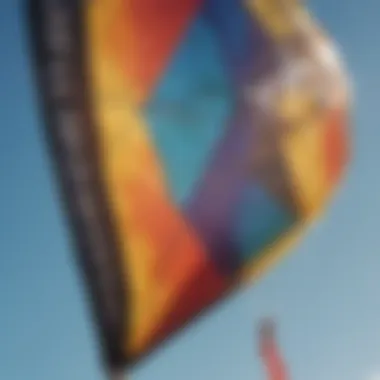

Advancements in Technology
Today, understanding our kites means appreciating the technological strides seen in design and materials.
- Materials: The transition from traditional paper and bamboo to synthetic materials has revolutionized kite performance. Nylon and polyester provide strength while being remarkably lightweight, ensuring a fine balance of durability and maneuverability.
- Design Innovations: The contemporary kite features a range of shapes and sizes that cater to different styles—be it a steady glider or an agile acrobat. This makes it vital to understand which design matches the kiteboarder’s preferred experience.
- Construction Techniques: Enhanced construction methods, including double stitching and reinforced seams, pave the way for safer, more reliable kites that suit all levels of expertise. It’s more than just stitching; it's about crafting a product that stands up against rough winds and turbulent waters.
- Smart Technology: Emerging trends include integrating smart features into kites. This could mean sensors that monitor and relay real-time performance data back to the kiteboarder, offering insights that were unimaginable in previous generations.
In sum, the advancements made in kite design are numerous and significant. Each leap into the realm of technology brings kiteboarding closer, not just to the ideal of performance, but also to safety and enjoyment for all who dare to take flight.
Essential Features of High Quality Kites
When diving into the world of high-quality kites, understanding the essential features becomes paramount. The distinction between a top-tier kite and an average one often lies in these features. Components such as the materials used, construction techniques, and overall design play a crucial role in not just the kite's performance but also its longevity and ease of use. For kiteboarders, these features can greatly influence how enjoyable the sport can be, impacting everything from lift and power to handling in varying wind conditions.
Material Choices
Nylon vs. Polyester
Considering material choices is critical when selecting a quality kite. Nylon and polyester are two popular fabrics for kite construction, and each has its own merits. Nylon is often favored for its superior strength-to-weight ratio. While being durable, it retains flexibility, thus providing great performance during dynamic maneuvers. On the flip side, polyester offers excellent resistance to UV rays and is less prone to stretching when wet, making it a solid choice for prolonged exposure to the elements.
In a nutshell, when deciding between nylon and polyester, one needs to think about the conditions they are likely to face. Nylon is advantageous for performance-oriented kiteboarding, where flexibility and strength are essential. It is particularly useful in demanding conditions, allowing for spirited flight. However, nylon can degrade quicker if left unprotected from the sun's harmful rays. Polyester, while slightly heavier, shines in terms of durability and longevity. It works well for kiteboarders who might use their gear frequently but want to ensure it stands the test of time.
Ripstop Fabric Benefits
Ripstop fabric takes kite material selection a step further. The unique trait of ripstop is its grid pattern, which prevents tears from spreading. This becomes pivotal in maintaining the kite's integrity. Ripstop fabric is both lightweight and durable, providing the perfect balance needed for kite flying. While it may come at a slightly higher price, its resistance to wear can save money in the long run due to less frequent replacements.
For kiteboarders, investing in a kite made from ripstop fabric is like buying a good insurance policy. You know that in the harsh wind and during aggressive flying, it can withstand incidences that might otherwise ruin a standard kite. Plus, the reduction in overall weight without compromising strength helps improve aerodynamics, which is vital for performance.
Construction Techniques
Seam Types
Another vital aspect influencing kite quality lies in the construction techniques, specifically seam types. The seams must be as strong as the material itself. Generally, there are flat seams, overlock seams, and zigzag seams. Each type presents unique benefits. Flat seams reduce bulk, allowing for an elegant design, while zigzag seams provide extra durability, a crucial point for high-stress areas of the kite.
For kiteboarders looking for stability and performance, opting for kites with reinforced seams can improve overall durability. A well-constructed seam will ensure that the kite holds up beautifully, even in the most unyielding conditions. Zigzag seams, for example, while somewhat bulkier, are highly effective at absorbing stress, making them a popular choice for performance kites.
Reinforcement Areas
Reinforcement areas are yet another aspect that cannot be overlooked when assessing kite quality. These regions have additional stitching or material to ensure that high-stress points can withstand the rigors they endure during use. Common reinforcement areas are around the kite's leading edges and attachment points for lines.
Having reinforced areas signifies a thoughtfully designed kite—especially for those getting into more demanding kiteboarding. It's essentially putting on a seatbelt in a car; necessary for safety and performance. Strong reinforcement prevents wear and can significantly enhance the kite's lifespan. Depending on the use and conditions, choosing a kite with adequate reinforcement will save both hassle and expenses in the future.
Performance Metrics: What to Look For
When it comes to high-quality kites, understanding performance metrics is paramount. These metrics dictate not just how a kite flies, but how enjoyable and safe the experience can be. For those new to the kiteboarding scene or even seasoned pros, knowing what to look for in lift, power, stability, and control simplifies the decision-making process. We want every kite enthusiast to fly with confidence, achieving the thrill of gliding effortlessly above the waves.
Lift and Power
Lift is the force that raises the kite into the air, and it plays a crucial role in kite performance. A kite that's efficient in generating lift translates to a more exhilarating ride. Proper lift depends on various factors including the kite's shape, size, and design. For instance, larger kites tend to produce more lift in lighter wind conditions, while smaller kites excel in stronger winds.
Consider this: the aspect ratio of a kite is indicative of lift potential. Kites with higher aspect ratios, like the Slingshot RPM, will fly faster and higher since they cut through the air more efficiently. Conversely, kites with lower aspect ratios, often seen in more beginner-friendly models, provide a more stable lifting experience.
When examining lift, keep an eye on the angle of attack. Higher angles can increase lift but may also cause stalling, while lower angles offer more speed but less elevation. It's a balancing act that makes all the difference in achieving the right feel for each rider's style.
Stability and Control
Stability and control are the bedrock principles that ensure a safe and enjoyable experience. A kite that's stable in the air allows for smoother rides and less likely dives or falls. Stability primarily arises from the kite's design and the balance of its components. Understanding how these elements come together can aid significantly in making choices.
Control involves how easily a rider can maneuver the kite. Wind can be fickle, and a responsive kite is invaluable. For instance, a kite like the Cabrinha Switchblade offers both stability and responsiveness, making it a favorite among riders of varying skill levels.
Key aspects to consider include:
- Bridle System: A well-designed bridle can enhance stability and response time.
- Wing Shape (Delta, Bow, etc.): Different shapes impact how a kite handles wind pressure. Delta kites, for example, are renowned for easy relaunching and overall stability.
- Bar Control: The quality of the control bar can significantly influence the rider's ability to steer and react to changes in wind conditions.
In wrapping this up, knowing what metrics to focus on helps kiteboarders make informed decisions that elevate their enjoyment and safety on the water. Between lift and power, and stability and control, there’s a world of difference in the experience each kite can provide.
Choosing the Right Kite
Choosing the right kite is a pivotal moment, not just for novices but also for seasoned kiteboarders. The vast range of kites available can turn decisions into a daunting task. However, understanding specific elements—like skill level and wind conditions—offers clarity. The appropriate choice can elevate one’s experience, leading to smoother rides, enhanced enjoyment, and safety.
Selecting the perfect kite isn't merely about price or aesthetics; it’s about finding a match that aligns with one’s abilities and the environment. Kiteboarding becomes an immensely rewarding sport when the right kite mirrors the user’s capability and the conditions at hand.
Factors to Consider
Skill Level
When you’re delving into the world of kites, **skill level ** stands out as a crucial determinant in selection. An individual’s experience plays a significant role in not just handling the kite but also understanding its nuances. Beginners will often find stability a dominant requirement, while more seasoned practitioners might seek performance-oriented kites.
For beginners, a user-friendly kite is paramount. A kite that doesn’t overpower the user helps in building skills progressively. This means less frustration and more fun; it’s like learning to ride a bike with training wheels. Conversely, experts might prefer a kite that provides agility and speed, pushing the envelope further to enhance tricks or speed runs.
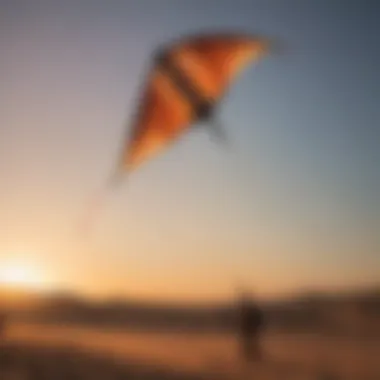

However, it’s also vital to consider transitioning; a kite that feels comfortable when you’re starting out might not suffice when you start pursuing complex maneuvers.
Wind Conditions
Wind conditions, another key characteristic, directly affect kiteboarding experiences. The nuanced interplay between the wind's force, gusts, and direction can determine the kite’s performance. Underestimating or misunderstanding these conditions can lead to mishaps, so it becomes wise to carefully select equipment based on expected wind scenarios.
For instance, a kite designed for strong winds can feel heavy and uncontrollable in gentle breezes, much like wearing a thick jacket on a warm summer day. Choosing a kite that corresponds well to the conditions can provide stability and confidence, allowing you to focus on mastering your skills.
Given that not all kites perform optimally across various wind conditions, assessing the conditions before heading out is indispensable.
Types of Kites Explained
Leading Edge Inflatable (LEI) Kites
Leading Edge Inflatable kites are popular for a reason, offering versatility across various types of conditions. The air-filled leading edge gives them structure, allowing them to remain inflated and retain shape even during turbulent winds. This characteristic makes LEIs ideal for beginners and pros alike, accommodating a range of skills and styles.
Their design grants users the ability to generate significant lift, allowing for impressive jumps and tricks. However, the air pressure requires regular maintenance, meaning that if you’re not diligent about checking for leaks, you might find yourself grounded when you want to be soaring.
Foil Kites
On the flip side, foil kites capture attention with their entirely different setup. Instead of a rigid frame, they rely on internal air pockets, giving them a unique lightweight nature. Great for light wind conditions, Foil kites shine when the breeze is gentle, making them a fan-favorite for experienced kiteboarders who know how to harness their advantages.
While they can feel less stable than LEIs when the wind picks up, their ability to glide and stay aloft in scant wind speaks to their design prowess. For kiteboarders pursuing minimalism, foil kites provide an efficient option, making them a choice worth considering when assessing potential equipment.
Regardless of type, recognizing factors such as skill level and wind conditions allows for informed decisions when choosing kites. As uncertainty dissipates, the emphasis can shift back to enjoyment and mastery of kiteboarding.
Maintaining High Quality Kites
Maintaining kites properly is crucial if you want them to perform well and last a long time. This section dives into the essentials of care and storage, which can make a world of difference to your kite's lifespan and your enjoyment on the water or in the air.
Regular Care Practices
Regular care practices are fundamental to keeping your kite in optimal condition. This includes inspecting your kite before and after each use, as well as routine maintenance. For instance, checking for any tears, frayed lines, or damaged spars should become second nature. If you notice any issues, it’s better to fix them right away than to wait until you're on the beach, ready to fly. An early catch can prevent a potentially catastrophic failure when you're in the thick of it.
Another important aspect is to keep your kite clean. Sand, saltwater, and dirt can wear down the materials over time. A simple rinse with fresh water after each session will help minimize buildup, ensuring your kite remains as good as new for many seasons to come. Regularly checking for seaweed or other debris caught in your lines is also wise, as it can lead to unnecessary wear.
Storage Tips
Proper storage is just as critical as regular maintenance. How and where you store your kite can have a direct impact on its performance and longevity. Here are a couple of key pointers to keep in mind.
Proper Folding Techniques
Folding your kite properly is not just about tidiness; it actually helps maintain its structural integrity. The main characteristic of proper folding is that it prevents creases and stress points in the fabric, which can lead to premature wear or even tears. When folding, you should lay the kite flat on a surface, ensuring that all lines are untangled and free from knots. Then, fold it along its natural seams—this way, you're respecting its design and materials.
The unique feature of proper folding techniques is that it allows for easy packing and transportation without compromising the kite's shape. It's a beneficial choice especially for kiteboarders who are always on the move. A well-folded kite takes up less space and makes it easier to unpack when you're ready to hit the waves again.
Cleaning Recommendations
Keeping your kite clean is another vital piece of the puzzle. After you’ve rinsed off the salt and sand, you should pay attention to stubborn spots or stains that could affect performance. Using a soft sponge and some mild soap is generally recommended for any deep cleaning. Make sure you rinse it thoroughly afterward to remove all soap residue.
The key characteristic of cleaning recommendations is they aim to prevent mold and mildew, especially if the kite has been stored wet. Clean kites not only perform better but also look sharp—important for those who value aesthetics.
Before storing your kite, allowing it to dry fully is crucial, as this helps to prevent any unwanted odors or deterioration of the fabric. Overall, keeping your kite clean contributes significantly to its longevity and performance.
Tip: Always check your kite's manufacturer guidelines for any specific care instructions, as material types can vary greatly.
Maintaining high-quality kites requires diligence. Regular care and proper storage techniques can go a long way in extending your kite's life and enhancing your kiteboarding experience. Considering these aspects isn’t just smart; it’s essential for getting the most out of your adventures.
Safety Considerations with Kites
When engaging in kiteboarding, the thrill and excitement are undeniable; however, safety must always remain a priority. Understanding the essentials of safety considerations not only enhances one’s experience but also minimizes risks associated with this exhilarating sport. It’s crucial to grasp factors such as weather conditions and the integrity of your equipment, as these elements can significantly affect your performance and safety.
Understanding Weather Conditions
A clear understanding of weather conditions is paramount for any kiteboarder. Winds, as fickle as a cat on a hot tin roof, can change rapidly, impacting both the kite's performance and the rider's stability. Here are key aspects to consider:
- Wind Speed: Kites are engineered to perform optimally within specific wind ranges. Understand your kite's requirements — flying a kite in winds too strong can lead to loss of control, while light winds might hinder performance.
- Gusts and Lulls: Gusts can sneak up like a thief in the night. They result in sudden increases in wind speed, while lulls decrease it unexpectedly. Identify these patterns to maintain better control while riding.
- Weather Forecasts: Utilize apps or websites to check forecasts. Conditions can be trickier than they appear, so staying informed helps avoid unpleasant surprises.
It's wise to consult local kiteboarding communities, either in person or via forums such as reddit.com, for real-time insights.
Equipment Checks
Before hitting the waves, thorough equipment checks are essential. Relying on faulty gear can be a ticket to trouble that nobody wants. Here are some practical tips:
- Kite Condition: Inspect for tears, frays, or any wear and tear on the fabric. Look at the seams and edges; they should be intact to withstand pulling forces.
- Lines: Ensure the lines are free of knots and tangles. They must be strong and in good condition to control the kite effectively.
- Harness and Safety Gear: Check that your harness fits well and operates correctly. Your safety equipment, such as impact vests or helmets, should be in good condition as well. Don't risk a ride without the right protection!
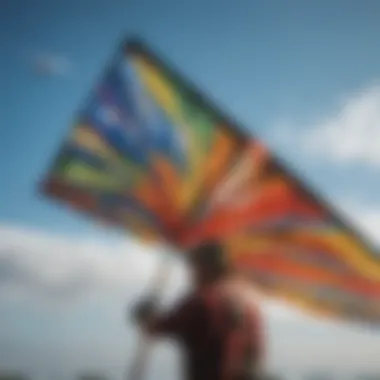

An equipment checklist can be a lifesaver. Here’s a simple example to follow:
- Inspect the kite for visual damage.
- Check all lines for tangles or frays.
- Confirm the integrity of the harness and safety gear.
"An ounce of prevention is worth a pound of cure."
Taking the time to perform these checks before each outing can significantly enhance safety and performance. Remember, safety might seem like a chore, but it’s the unsung hero of fun, allowing kiteboarders to enjoy the sport without constant worry. In a world where adrenaline and the urge to explore collide, these precautions offer a solid foundation on which to build your kiteboarding passion.
Innovations in Kite Technology
Innovations in kite technology play a critical role in shaping the way kite enthusiasts experience the sport. With advancements integrating both smart features and a commitment to sustainability, the landscape of kites has fundamentally transformed. Today’s kites not only enhance performance but also adapt to the environmental concerns of our time. By delving into these innovations, we can appreciate how they contribute to a more enjoyable and responsible kiteboarding experience.
Integration of Smart Features
The blending of technology with traditional kite design has birthed kites featuring smart attributes. These innovations range from embedded sensors to digital applications that connect to your smartphone.
Benefits of smart features include:
- Real-time performance tracking: Sensors can gather data about altitude, speed, and wind conditions, providing kiteboarders with actionable insights. Whether you're a novice or a seasoned pro, this information helps you adjust your technique and enhances overall performance.
- Enhanced safety: Many modern kites come equipped with alarms or alerts that inform users of unsafe conditions. If the wind suddenly changes or if the kite is not flying in an optimal manner, warnings can be sent directly to your device, allowing timely adjustments.
- Personalization: Users can customize settings for power, lift, and control. Depending on skill level and conditions, switching modes through an app allows kiteboarders to tailor their experience.
While these features can elevate your kiteboarding experience, it’s vital to understand the need for batteries and electronic parts, as they can affect the kite's overall weight and handling. Consequently, the balance between tech integration and traditional kite elements becomes crucial.
Sustainability in Kite Manufacturing
As awareness surrounding environmental issues grows, kite manufacturers are increasingly focusing on sustainability in their production processes. Understanding sustainable practices not only helps our planet but also promotes a responsible approach to enjoying kiteboarding.
Key aspects of sustainable kite manufacturing include:
- Materials: Many companies now use recycled materials in their kites. For example, kites made from repurposed plastics help reduce waste and decrease reliance on new resources. This initiative resonates with environmentally-conscious consumers who prioritize eco-friendly products.
- Eco-friendly production: From the manufacturing process to packaging, there are efforts to minimize the carbon footprint. Techniques that reduce water and energy use, as well as partnerships with certified green suppliers, are becoming standard in the industry.
- Longevity and repairability: The trend is shifting towards creating kites that last longer and can be easily repaired. This reduces the need for frequent replacements, thereby cutting down on waste and fostering a culture of sustainability among kite enthusiasts.
"Incorporating eco-friendly materials is not only good for the planet but also shows kiteboarders that they can indulge in their passion without compromising their values."
Community Insights: Kiteboarding Experiences
When it comes to kiteboarding, it’s not just about the thrill of gliding over water or catching the perfect breeze. The stories shared within the kiteboarding community add richness and depth to the overall experience. Interactions amongst kite enthusiasts often lead to a better understanding of the sport and help both novices and experienced riders navigate the waves of challenges they may face.
Personal narratives provide a glimpse into the joys and hurdles encountered on various journey's. Whether it's learning to handle the perfect kite for the first time or tackling adverse weather conditions, these stories underline the strength and camaraderie shared among kiteboarders. They also serve to inspire and motivate others and create a sense of belonging, essential to thriving in any community.
Learning doesn’t only stem from books or guidelines. Personal experiences from fellow kiteboarders often shape better practices. By hearing how someone overcame a particular obstacle or what gear they found indispensable, riders gain valuable insights.
"In kiteboarding, Community is just as important as skills and equipment; the shared experiences pave the way for safer and more enjoyable times on the water".
Personal Stories of Kite Enthusiasts
The kiteboarding community is filled with vibrant tales from individuals lured by the promise of windswept adventure. Take for instance, Rachel, a thirty-something from the coast. On her first outing, the thrill of launching into the air was overshadowed by a sudden gust.
She recalls zipping across the water, exhilarated by the speed, yet feeling a hint of dread as she lost control. Instead of tossing in the towel, Rachel gathered her guts, tapped into community wisdom from a local instructor, and dedicated herself to practice. Her perseverance paid off—now she's one of the best riders in her area, sharing her techniques with newcomers.
Or consider Marco, who ventured across continents, hoping to find the best kiteboarding spots. His story highlights how the passion for kiteboarding connects people from diverse backgrounds. From blustery beaches in Brazil to the calm winds of Cape Town, every encounter enriched his journey. Each new place brought lessons about the local tides, winds, and customs embedded in kiteboarding culture.
Expert Opinions on Best Practices
Gleaning knowledge from seasoned kiteboarders can significantly influence one's journey in the sport. Experts advocate for a blend of technique and safety, encapsulating efficient practices with insights drawn from encounters in both calm and tumultuous conditions.
Dr. Sam, a well-respected kiteboarding instructor, emphasizes the necessity of understanding wind patterns—she says, "Familiarizing yourself with how wind interacts with terrain can prevent several close calls. Let nature be your guide."
In terms of gear, professional kiteboarders frequently highlight the importance of tailored equipment. For instance, using the right kite size, adapted to individual weight and skill level, can make a notable difference. As Tom, an avid competitor, mentions: "The right kite can be your best friend or worst enemy; selecting one that fits your style can enhance performance dramatically."
Additionally, continuous learning stands out as a core tenet among the experts. Engaging with the community allows for skill enhancements, whether through social media platforms or local clubs.
The shared knowledge amongst the kitesurfing world translates to safer, more enjoyable experiences, fostering a community spirit where everyone contributes to each other’s growth.
Finale: The Future of High Quality Kites
The world of high-quality kites is at a pivotal juncture. As kiteboarding continues to gain popularity amidst adventurers and hobbyists alike, it's essential to look ahead at how kites will evolve. One key element in this future is the blend of technology and sustainable practices in manufacturing. Kite enthusiasts now demand more than just functionality; they want equipment that aligns with environmental consciousness. This means that innovations in materials and production processes can have a substantial impact on the kiteboarding landscape.
In recent years, researchers and manufacturers have pushed the envelope, creating kites that not only perform better but also minimize environmental impact. Take, for instance, the use of recycled plastics and organic materials. These not only reduce waste but also provide the same durability and performance levels that kiteboarders expect from their gear. As consumers become more discerning, products with a focus on sustainability are likely to become best-sellers.
Moreover, technology integration is changing the game. Smart kites equipped with sensors can monitor wind patterns and adjust their performance accordingly, offering a more tailored experience for users. This shift towards data-driven design could pave the way for advanced features, making kiteboarding more accessible and enjoyable, especially for those still finding their footing in the sport.
Benefits of High Quality Kites
- Enhanced Performance: With the advancement in materials and structures, modern kites offer better lift, control, and stability.
- Environmental Sustainability: The push for greener practices ensures that enthusiasts can ride the waves with a lesser carbon footprint.
- Tech-Enhanced Experience: Features like built-in sensors can help lower the learning curve for beginners, making the sport more inclusive.
Considerations for Kiteboarders
- As you assess the future options, think about what features matter most to you—is it performance, sustainability, or perhaps innovative technology?
- Be on the lookout for reputable brands that focus on both functionality and sustainable practices; they can be a solid investment for your kiteboarding journey.
As we gaze ahead, the harmony between technology, sustainability, and traditional kiteboarding remains a vibrant focus area. Continued dialogue and feedback from the community will undoubtedly shape the next iteration of high-quality kites. Embracing change now will ensure that kiteboarding thrives not just for current enthusiasts but also for future generations.
"Investing in a high-quality kite is not just about performance today; it's about shaping the future of kiteboarding for tomorrow's adventurers."
Looking forward, kiteboarding enthusiasts have all the reasons to stay optimistic. The horizon is broad, illuminated by innovation and positive changes. By keeping abreast with these trends, you're not just enhancing your own experience but also contributing to the broader community's growth.



